During JJ Bentley's time at the FA, he had clashed with the United players over their stance with the Players Union. Although he had previously supported the abolition of the maximum wage, he was quoted as saying the following in 1909: "The very suggestion of a strike of footballers shows the meanness of the motives behind it and in my judgement cannot be too strongly condemned".
Perhaps this was one of the reasons that club captain (and leader of the 1909 protest) Charlie Roberts was sold in the summer of 1913 to Oldham Athletic for a (record at the time) fee of £1,500. Also sold was his defensive partner Alex Bell, who went to Blackburn for £1,000. In turn, these are probably reasons why the 1913/14 season saw United finish in their lowest league position since their promotion in 1906 and exit the cup in the first round. Oldham, led by Roberts on the other hand finished in second place - to date, their best ever league position - while Bell's new club would win the title the season after that.
Perhaps this was one of the reasons that club captain (and leader of the 1909 protest) Charlie Roberts was sold in the summer of 1913 to Oldham Athletic for a (record at the time) fee of £1,500. Also sold was his defensive partner Alex Bell, who went to Blackburn for £1,000. In turn, these are probably reasons why the 1913/14 season saw United finish in their lowest league position since their promotion in 1906 and exit the cup in the first round. Oldham, led by Roberts on the other hand finished in second place - to date, their best ever league position - while Bell's new club would win the title the season after that.
The 1913/14 United team, pictured before a practice match, in various jerseys they had also worn in previous seasons:
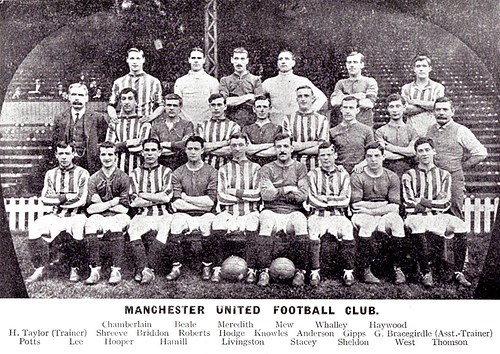
This is an edited version of an image from the extensive Leslie Millman collection, which can be found at www.flickr.com/photos/manchesterunitedman1/

This is an edited version of an image from the extensive Leslie Millman collection, which can be found at www.flickr.com/photos/manchesterunitedman1/
Another photo from that season shows them in home shirts with white collars. These jerseys are similar to those worn in the 1911/12 team photograph, but have a button on the white part, much like a traditional "grandad collar":
A third photograph dating from November 1913 shows the players in change jerseys with thicker stripes than had been previously worn. These would be used until the early 1920s:
Despite the outbreak of the First World War in June 1914, the 1914/15 football season went ahead as usual. United had attempted to make up for the loss of their key defenders by signing Chelsea's George Hunter towards the end of the previous season for £1,300 and Patrick O'Connell during the summer for £1,000. These were large fees for the time, but Hunter would not complete a full season for the club, while O'Connell became the club's new captain.
The 1914/15 team before a practice match. The thin striped change shirts are used once more:
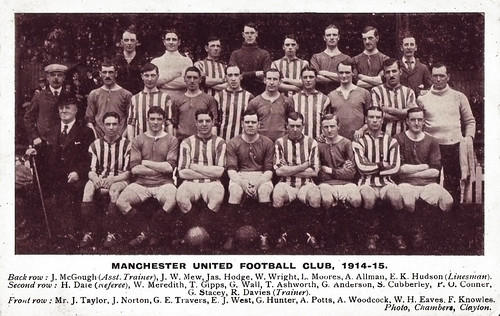
This is an edited version of an image from the extensive Leslie Millman collection, which can be found at www.flickr.com/photos/manchesterunitedman1/ and is used with full permission.

This is an edited version of an image from the extensive Leslie Millman collection, which can be found at www.flickr.com/photos/manchesterunitedman1/ and is used with full permission.
Just after Christmas of 1914, Bentley, who was in ill health, was replaced by John "Jack" Robson, previously in charge of Brighton & Hove Albion. He would be the first at United to take the title of "Manager" rather than "secretary", and stayed with the club until 1921.
This change of leadership did not greatly help United (who up until that point had only won three games that season), as they continued to struggle and indeed were fighting to save themselves from relegation. In the end they were saved by just one point, but there would be more controversy, as several players found themselves embroiled in a match-fixing scandal.
The game against Liverpool on April 2nd, which United won 2-0 was under scrutiny after Liverpool's lackadaisical approach had seen them concede easily and miss a penalty. Weeks later, a £50 reward was being offered by a bookmakers for information that could help prove the match had been fixed. They had an unusual number of big-money bets had been placed on United to win the fixture 2-0. The odds were 7-1 and when the press heard of it there was a scandal brewing.
The Football League launched an investigation in May which went on until they released their findings the following December. They had uncovered damning evidence that there had indeed been a conspiracy to fix the game. Although the clubs as a whole were judged to have been unaware of the plot, the Football League found that three United players, four Liverpool players and a Chester FC player were at the centre of it. They were banned from football for life.
The United players involved were Sandy Turnbull, Arthur Whalley and Enoch West (the only one of them to have actually played in the game). The Liverpool players included Jackie Sheldon, who had been at United from 1909-13, and who acted as the go-between. West would never admit guilt in the case and even took the Football League to court for libel over their ruling. As a result of this, when the other players were pardoned after the war (which finally brought about a suspension of the league that summer), West was not. His ban was eventually lifted in 1945 when he was 59 years old. Whalley played again for United after the war, but tragically Turnbull, United's FA Cup hero, was a casualty of war - killed fighting in Arras, France, in 1917.
A rare photograph of a United team during the war. This was taken in 1916 and features George Wall, who did not go to fight in the war and an 18 year old Jack Silcock (top, second from right), a defender who would go on to represent England internationally:
This change of leadership did not greatly help United (who up until that point had only won three games that season), as they continued to struggle and indeed were fighting to save themselves from relegation. In the end they were saved by just one point, but there would be more controversy, as several players found themselves embroiled in a match-fixing scandal.
The game against Liverpool on April 2nd, which United won 2-0 was under scrutiny after Liverpool's lackadaisical approach had seen them concede easily and miss a penalty. Weeks later, a £50 reward was being offered by a bookmakers for information that could help prove the match had been fixed. They had an unusual number of big-money bets had been placed on United to win the fixture 2-0. The odds were 7-1 and when the press heard of it there was a scandal brewing.
The Football League launched an investigation in May which went on until they released their findings the following December. They had uncovered damning evidence that there had indeed been a conspiracy to fix the game. Although the clubs as a whole were judged to have been unaware of the plot, the Football League found that three United players, four Liverpool players and a Chester FC player were at the centre of it. They were banned from football for life.
The United players involved were Sandy Turnbull, Arthur Whalley and Enoch West (the only one of them to have actually played in the game). The Liverpool players included Jackie Sheldon, who had been at United from 1909-13, and who acted as the go-between. West would never admit guilt in the case and even took the Football League to court for libel over their ruling. As a result of this, when the other players were pardoned after the war (which finally brought about a suspension of the league that summer), West was not. His ban was eventually lifted in 1945 when he was 59 years old. Whalley played again for United after the war, but tragically Turnbull, United's FA Cup hero, was a casualty of war - killed fighting in Arras, France, in 1917.
A rare photograph of a United team during the war. This was taken in 1916 and features George Wall, who did not go to fight in the war and an 18 year old Jack Silcock (top, second from right), a defender who would go on to represent England internationally:
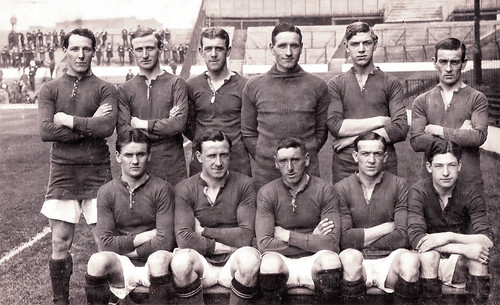
This is an edited version of an image from the extensive Leslie Millman collection, which can be found at www.flickr.com/photos/manchesterunitedman1/ and is used with full permission.
The jerseys the players are wearing in the above photograph are very much like some of those those worn from 1911-14, albeit with the addition of white trim behind the buttons:

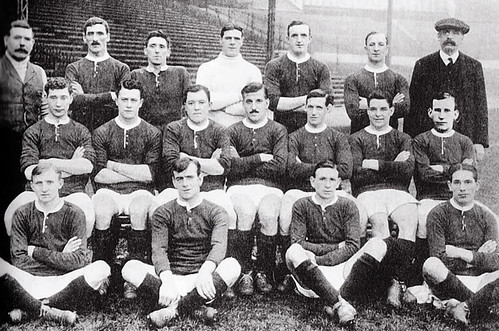
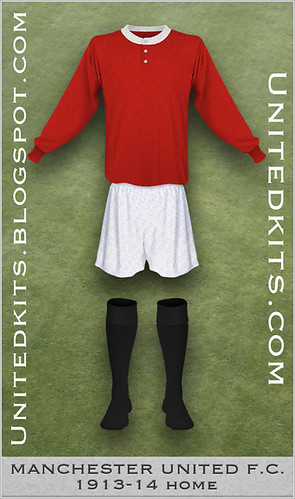
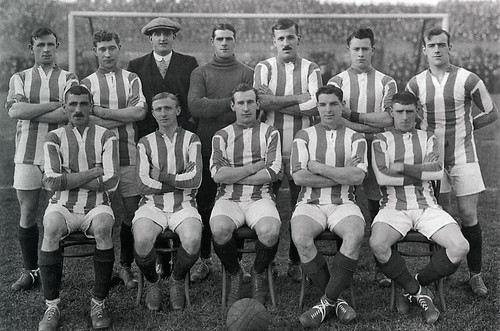
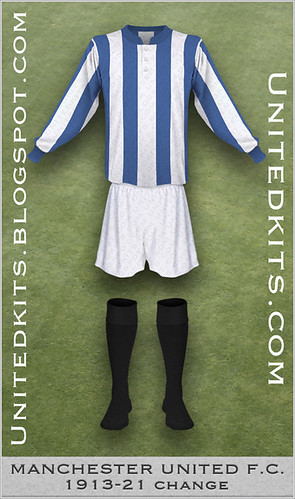
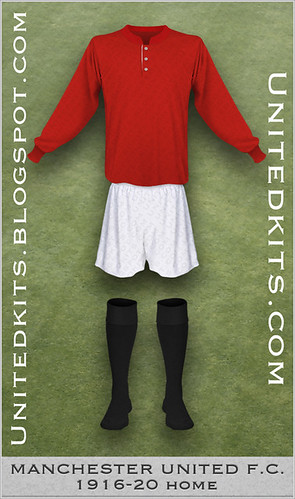
No comments:
Post a Comment